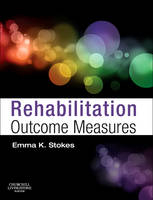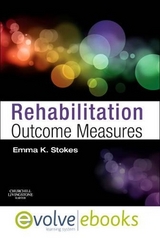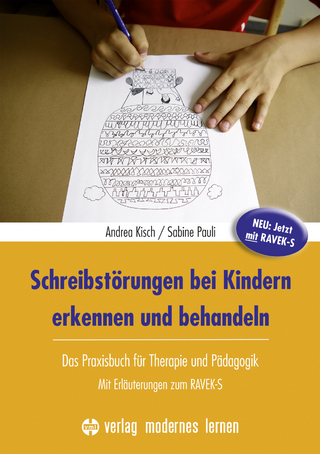
Rehabilitation Outcome Measures
Churchill Livingstone (Verlag)
978-0-443-06915-4 (ISBN)
- Titel erscheint in neuer Auflage
- Artikel merken
Rehabilitation Outcome Measures is a comprehensive review and comparison of measurement instruments in rehabilitation. It includes a high-level section on professional practice in physiotherapy and an introduction to the World Health Organisation's (WHO) International Classification of Health. For those who wish to learn more about the relevance of reported measurement properties, the text focuses on how this knowledge can assist clinical decision-making. Additionally, the book reviews a range of measurements in neurological rehabilitation as well as mobility, fatigue, physical activity and patient satisfaction. Rehabilitation Outcome Measures is directed at students preparing for clinical practice, as well as researchers and practitioners seeking information about a range of measurement instruments.
Provides details on how to manage a project and select an outcome measure
Introduction to WHO's International Classification of Functioning, Disability and Health
Boxes with specific links to clinical decision-making
Easy format for review of measurement possibilities in each domain
Clear review of 36 measurement instruments
Dedication
Acknowledgements
Preface
SECTION 1 OUTCOME MEASUREMENT IN CONTEXT
1 Outcome measurement and practice
Introduction
Chapter outline
The outcomes movement
Evidence-based practice
The role of professional organizations in promoting the systematic use of SOMs
Summary
2 International classification of functioning, disability and health (ICF)
Introduction
Chapter outline
What is ICF?
3 How to choose an outcome measure
Introduction
Chapter outline
Project manage the process of choosing and using OMs
How do I choose a measure to use in my clinical practice?
Different types of measures
Assessing the quality of a measure
Summary
SECTION 2 MEASUREMENT PROPERTIES
4 Reliability: error in measurement
Introduction
Chapter outline
What is reliability?
How are studies of reliability analysed?
What not to use or to interpret with caution
Summary
5 Validity
Introduction
Chapter outline
The description and methodology of validity
Predicting the future - how can we use OMs to predict future events?
Can the outcome measure tell the difference between two groups?
Summary
6 Measuring change
Introduction
Chapter outline
Studying responsiveness
Summary
SECTION 3 OVERVIEW
7 Measuring mobility
Introduction
Table 7.1 Emory Functional Ambulation Category (E-FAP) and Modified Emory Functional Ambulation Category (mE-FAP)
Table 7.2 Hierarchic assessment of balance and mobility (HABAM)
Table 7.3 Elderly Mobility Scale (EMS) and Swedish Modified EMS (Swe mEMS)
Table 7.4 Rivermead Mobility Index (RMI) and Modified Rivermead Mobility Index (mRMI)
Table 7.5 High-level Mobility Assessment Tool (HiMAT)
Table 7.6 Physiotherapy Functional Mobility Profile (PFMP) and Physiotherapy Functional Mobility Profile Questionnaire (PFMP-Q)
Table 7.7 University of Alabama at Birmingham Study of Aging Life Space Assessment (UAB - LSA)
Table 7.8 Trinity Test of Functional Mobility (TTFM)
Table 7.9 The Activities-specific Balance Confidence Scale (ABC)
8 Measuring physical activity
Introduction
Table 8.1 StepWatchT Monitor - Step Activity Monitor (SAM)
Table 8.2 RT3 accelerometer
Table 8.3 Physical Activity and Disability Survey (PADS) and Revised Physical Activity and Disability Survey (R-PADS)
Table 8.4 Physical Activity Scale for the Elderly (PASE)
Table 8.5 Stanford 7-Day Physical Activity Recall Questionnaire (7D-PAR) (PAR)
9 Measuring fatigue
Introduction
Table 9.1 Barrow Neurological Institute (BNI) Fatigue Scale
Table 9.2 Brief Fatigue Inventory
Table 9.3 Revised Piper Fatigue Scale (R-PFI)
Table 9.4 Multi-dimensional Fatigue Inventory (MFI-20)
Table 9.5 Fatigue Severity Scale (FSS)
Table 9.6 Fatigue Impact Scale (FIS) & its derivatives - Daily Fatigue Impact Scale (D-FIS), Modified-Fatigue Impact Scale (M-FIS) and Fatigue Impact Scale for Chronic Obstructive Airways disease (COPD) (FIS-25)
10 Measuring neurological conditions and rehabilitation
Introduction
Table 10.1 Scales for Outcomes in Parkinson's Disease (SCOPA) - Short Parkinson's Evaluation Scale (SPES)
Table 10.2 Freezing of Gait Questionnaire (FOG-Q) and New Freezing of Gait Questionnaire (NFOG-Q)
Table 10.3 Postural Assessment Scale for Stroke (PASS)
Table 10.4 Trunk Impairment Scale (TIS)
Table 10.5 Multiple Sclerosis Impact Scale (MSIS-29)
Table 10.6 Stroke Impact Scale
Table 10.7 Motor Assessment Scale
11 Evaluating satisfaction
Patient satisfaction: why measuring it is important
Table 11.1 Patient Satisfaction Questionnaire (PSQ)
Table 11.2 Physical Therapy Outpatient Satisfaction Survey (PTOPS) and European version (EPTOPS)
Table 11.3 MedRisk, MRPS
Table 11.4 Patient Satisfaction with Physical Therapy (PSPT)
Table 11.5 Cystic Fibrosis Chest PT Satisfaction Survey
Table 11.6 Patient Satisfaction Questionnaire (PSQ)
APPENDICES
Appendix 1 Mobility
Introduction
Emory Functional Ambulation Profile Scale and Modified Emory Functional Ambulation Profile Scale
Hierarchic assessment of balance and mobility (HABAM)
Elderly Mobility Scale and Modified Elderly Mobility Scale
Rivermead Mobility Index and Modified Rivermead Mobility Index
University of Alabama at Birmingham Study of Aging Life Space Assessment
High Level Mobility Assessment Tool (HiMAT)
The Activities-specific Balance Confidence (ABC) Scale
Physiotherapy Functional Mobility Profile
Trinity Test of Mobility
Appendix 2 Physical activity
Introduction
The Physical Activity Disability Survey (PADS)
Appendix 3 Fatigue
Introduction
Fatigue Severity Scale
Fatigue Impact Scales
Barrow Neurological Institute (BNI) Fatigue Scale
Brief Fatigue Inventory (BFI)
Modified Piper Fatigue Scale
Multidimensional Fatigue Inventory (MFI-20)
Appendix 4 Neurological rehabilitation
Introduction
Trunk Impairment Scale (TIS)
Multiple Sclerosis Impact Scale (MSIS-29) Version 2
New Freezing of Gait Questionnaire
Postural Assessment Scale for Stroke (PASS)
Short Parkinson's Evaluation Scale (SPES/SCOPA)
Motor Assessment Scale (MAS)
Appendix 5 Patient satisfaction
Introduction
Physical Therapy Outpatient Satisfaction Survey (PTOPS)
European POPTS
Chest Physiotherapy Satisfaction Survey
Physical Therapy Patient Satisfaction Questionnaire
MedRisk
Physiotherapy Outpatients Satisfaction Questionnaire
Patient Satisfaction Questionnaire
Index
| Erscheint lt. Verlag | 30.12.2010 |
|---|---|
| Verlagsort | London |
| Sprache | englisch |
| Maße | 189 x 246 mm |
| Gewicht | 410 g |
| Themenwelt | Medizin / Pharmazie ► Pflege |
| Medizin / Pharmazie ► Physiotherapie / Ergotherapie ► Ergotherapie | |
| Medizin / Pharmazie ► Physiotherapie / Ergotherapie ► Rehabilitation | |
| ISBN-10 | 0-443-06915-8 / 0443069158 |
| ISBN-13 | 978-0-443-06915-4 / 9780443069154 |
| Zustand | Neuware |
| Haben Sie eine Frage zum Produkt? |
aus dem Bereich



